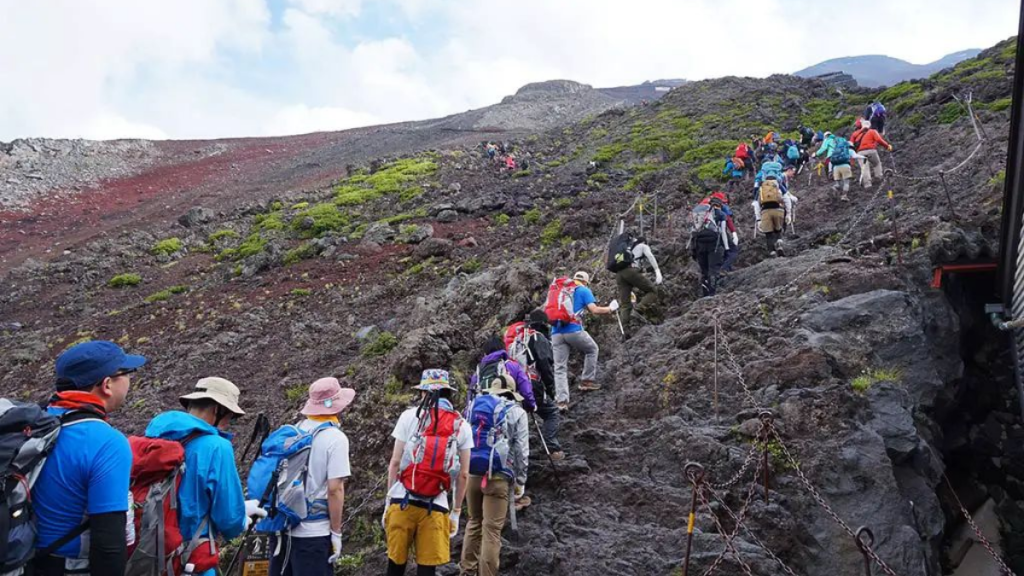KUALA LUMPUR, 17 March 2025 – Starting this summer, Japan’s iconic Mount Fuji will introduce a mandatory hiking fee of ¥2,000 (approximately $13.25) per climber across all four main trails. The initiative aims to control over-tourism, improve safety measures, and protect the delicate ecosystem of the UNESCO World Heritage site.
Growing Concerns Over Mount Fuji’s Overcrowding

For years, Mount Fuji has struggled with overcrowding, particularly during peak climbing seasons in July and August. In 2023 alone, more than 300,000 climbers attempted to reach the summit, leading to congestion, pollution, and safety hazards along the trails. The influx of tourists has put immense pressure on the mountain’s fragile environment, resulting in excessive waste, trail erosion, and safety risks.
Local authorities, environmentalists, and tourism officials have repeatedly raised concerns over the deteriorating conditions of Mount Fuji. Some climbers, in their rush to the summit, have engaged in “bullet climbing”—a practice where hikers attempt to reach the peak in one go without resting. This has led to exhaustion, altitude sickness, and increased rescue operations, straining local emergency services.
Why Introduce a Mandatory Fee?
The decision to impose a mandatory fee is part of a broader effort by the Yamanashi and Shizuoka prefectural governments to regulate climbing activities and fund environmental conservation projects. While a voluntary donation system has been in place since 2013, only about 60% of hikers contributed, making it insufficient to address the escalating issues.
“The funds collected will be used to enhance trail maintenance, improve public facilities, and expand safety measures to protect both climbers and the environment,” said Yamanashi Governor Kotaro Nagasaki.
The fee will be enforced at all entry points, and hikers without proof of payment will not be allowed to proceed beyond checkpoints. Additionally, authorities are considering introducing a daily climber cap to further regulate the number of hikers allowed each day.
Reactions from Local Officials and Climbers
The new policy has received mixed reactions from both local officials and international hikers.
Support for the Initiative
Many environmentalists and local officials applaud the decision, seeing it as a necessary step to preserve Mount Fuji’s natural beauty. Professor Hiroshi Tanaka, an environmental scientist at Tokyo University, argues that the fee is a reasonable price to pay for long-term conservation.
“If we want to ensure that future generations can still experience the beauty of Mount Fuji, we need to take these measures now. The revenue generated will directly fund waste management, emergency response, and sustainable tourism initiatives,” he explained.
Local business owners also believe the initiative will help reduce excessive foot traffic and promote quality tourism rather than mass tourism.
Opposition from Tourists and Travel Operators
On the other hand, some climbers and travel operators disagree with the fee, arguing that Mount Fuji should remain freely accessible to all.
Mika Sasaki, a tour guide who leads groups up Mount Fuji, believes the added cost may deter budget travelers and domestic hikers from visiting.
“While we understand the need to manage over-tourism, this fee could discourage some hikers, especially students and backpackers who cannot afford additional expenses,” she commented.
Some tourists also raised concerns that the hiking fee may lead to unauthorized climbing routes, where hikers attempt to bypass official trails to avoid payment, potentially creating new safety risks.
Environmental and Economic Impact
The hiking fee initiative is expected to have both short-term and long-term effects on the environment and local economy.
Positive Impacts
- Preserving Mount Fuji’s Ecosystem – The funds will allow authorities to implement waste disposal programs, repair trails, and maintain visitor facilities.
- Enhancing Safety – Increased funding will support rescue teams and medical stations along the mountain, reducing the number of fatalities and injuries.
- Sustainable Tourism Model – Prioritizing quality tourism over high-volume traffic will allow a better visitor experience and a more balanced approach to conservation.
Potential Challenges
- Impact on Local Tourism Revenue – Fewer climbers may affect businesses that rely on high tourist footfall, such as hostels, restaurants, and rental shops.
- Unregulated Climbing – Some climbers might avoid official routes, leading to increased illegal entries and potential accidents.
Will Other Destinations Follow Suit?
Japan is not the first country to introduce such measures. Other popular natural landmarks, such as Machu Picchu in Peru and Mount Everest in Nepal, have long implemented entry fees and climber regulations to prevent environmental degradation.
As global concerns about over-tourism and climate change grow, other natural attractions may also follow Japan’s lead in imposing conservation-focused fees.
Long Term Benefits of Preserving the Landmark
The decision to enforce a mandatory hiking fee at Mount Fuji reflects Japan’s growing commitment to sustainable tourism and environmental conservation. While the move may be controversial, the long-term benefits of preserving one of the world’s most famous landmarks outweigh the short-term inconveniences.
As the new regulation takes effect, the success of this initiative will depend on how well it is enforced and whether visitors comply with the new guidelines. If executed properly, it could set a precedent for how other iconic tourist destinations manage their environmental footprint.
For more updates on global tourism policies, environmental conservation, and travel advisories, stay connected with ForwardMalaysia.my.